Milton 10/252
a Vermont 251 essay
This is an entry in my Vermont 251 Club series. The main post — which lists all 252 places in Vermont — is here. As I visit each one and write about it, the name will become a live link. The first one, telling the story of my adventure in Middlebury, is not behind any paywall and is available here. Richmond, home of The Round Church, is here.
This one isn’t paywalled, as it’s my favorite so far, but most of the series is/will be paywalled, so if you think you would enjoy reading more of these, consider subscribing. Here’s a coupon.
Milton’s vibe is a little weird — but not in the way Randolph’s is.
Where Randolph feels like it’s still trying to decide what it wants to be, Milton seems sure of itself. It knows what it is and what it’s aiming for — just not as one cohesive whole.
Instead, it’s segmented. Milton has actual neighborhoods and areas, each with its own personality — working-class streets where the yards are so small kids can play catch from their own driveways; neighborhoods with larger houses on the typical Vermont gentrification quarter-acre minimums; merchant areas that serve the upscale and merchant areas with laundromats — instead of the “everything-next-to-everything” randomness you get in Randolph, where the Lucky Bugger Winery sits right beside Fellowship Baptist Church like a punchline no one meant to write.
Even its name hints at a layered identity. Local lore says it honors the poet John Milton, but historians lean toward a different origin: Viscount Milton, William FitzWilliam, a British aristocrat who openly supported American independence.
That Revolutionary-era quirk — part literary flourish, part political statement — feels fitting for a town that contains multitudes without mashing them into one flavor.
I’m a dry media artist — graphite and colored pencil — who has recently launched a little side business selling originals and prints.1
So of course my destination in Milton had to be the Milton Artists’ Guild.
It’s not just a gallery. It’s a sprawling, light-filled, relentlessly welcoming hub for more than 150 artists, with dedicated spaces for exhibitions, workshops, and community events.
It’s the kind of place that doesn’t just show art — it actively generates it, drawing people in to make, talk, and learn. I’ve been to a lot of art spaces in Vermont, but this one is amazing, awesome, and excellent in the truest sense. I absolutely love it.
By the time you’re done reading, you’ll see why —and I’ve included dozens of pictures so you can have a proper virtual tour.
Where Artists Belong
Vermont is full of artists.
It’s not just that the natural beauty here inspires people — though it does, and the effect can’t be overstated — it’s that the state is collectively determined to keep that beauty intact.
Signage is heavily regulated, billboards are banned entirely, and the result is a visual calm you don’t notice until you leave.
Cross the border into any other state and you feel visually assaulted: giant ads shouting at you from every angle, a constant fight for your attention.
I don’t like the nanny state. I find it infantilizing and annoying. But this is my one exception. If the law regulating signage were up for debate, I’d go door to door collecting signatures myself.
That sounds contradictory, and maybe it is, but I don’t think so.
Digital fasts work the same way. Anytime we take a real break from our phones — hours, days, a weekend without the constant ping and scroll — we come back determined to quit entirely, or at least to cut way back.
The addiction takes a toll we don’t notice until we’re free of it, and then the contrast is so stark we can’t believe we tolerated it.
That’s how the signage law feels to me. From my perspective, Vermont is like living in a device-free state while the rest of the country has its face glued to a screen, and I have no interest in giving that up.
Here, the views of real life win. And when the landscape is that uncluttered, the creative work that emerges from it feels different — less defensive, more grounded.
That’s part of why the Milton Artists’ Guild is as strong as it is, especially for a town of just over 10,000.
If an artist collective of this size and quality was going to thrive anywhere, it would be here, in a state where the background is already beautiful and the foreground is full of people making more beauty.
The Building Full of Temptation
I knew before I even stepped inside the Milton Artists’ Guild that there’d be plenty of the kind of art that makes me weak in the knees: rustic slices of real life, the sort of imagery that feels like it was pulled straight from the Vermont I see when I look out the window. I had even been saving up for this trip — and yes, I give myself an “allowance” of $50 a paycheck, like a particularly well-behaved teenager with a paper route.
One of the great things about MAG is that the art is surprisingly affordable. That’s partly because Vermont has so many working artists creating beauty out of the landscape that the market itself keeps prices in check, and partly because the Guild clearly wants to make sure anyone can take something home.
I’ve thought a lot about pricing myself — I’ve deliberately kept my own prints a bit on the high side, not because I think my work is worth more than anyone else’s, but because I have readers on disability or Social Security who pay to subscribe to me. When I find out, I always comp them — I don’t need someone’s welfare check funding anything in my life, and particularly not my DIY student loan exorcism — but I also know how easy it is for people to stretch too far when they want to help. By keeping my prices up, I hope I’ve made that less likely.
And this experience has given me fresh theory-of-mind for pricing. The wooden bowl I loved and wanted to buy for staging still life practice — $170 — was a no, but I get why it was priced that high. It was stunning and handmade. On the other hand, there were $40 earrings that I thought could’ve gone for $200, easy. I wear earrings only once or twice a year when I dress up, but they were definitely the kind of thing I would wear on those special nights.
I also really loved the work of the director, who is one of the artists who shows there. Colored pencil and graphite work is rarely shown in museums, at least here in New England. I’ve looked many times so I could drag
to a museum with me to see them — and exhibits just don’t happen.It’s paintings, sculpture, paintings, mixed media, paintings, and paintings. (Also paintings.)
But her colored pencil work is so gorgeous that it could pass for a photograph, and it makes me happy to know it exists.
Regardless of prices, MAG was exactly the kind of place where temptation runs high. I wanted a lot of what I saw — paintings, colored pencil works, photography, jewelry, soap, honey, sculptures, whimsical crafts — but I limited myself to two prints I absolutely loved, plus a greeting card and some pumpkin pie–scented soap. I got out for under $100, which, considering my track record in art stores2, is a personal victory.
My favorite thing? Without question, the print you see here: Kimbarlee Forney’s Starry Night, only with a row of plump white sheep standing where Van Gogh left open fields.
The concept sounds like it should be kitsch, but in person it’s both whimsical and oddly contemplative. It’s playful, yes, but it also made me think about pop art, reproduction, and the way we insert ourselves into art history.
I don’t think that liking “pop art” makes anyone a sheep — but there’s something clever about the visual pun. I hung it directly under my LEGO version of the same painting, which itself hangs above the six-cube organizer that holds the bulk of my art business.
Between the two, my wall now has both the pixelated chunkiness of plastic bricks and the soft, rounded charm of sheep, and somehow it works.
Other finds included a greeting card featuring a vintage blue truck with pumpkins spilling from the bed, and a delightfully ridiculous chicken painting where one bird, mid-hatch, snarks to another: “And you complained about your kidney stones!”
This is exactly the range of MAG — you get the refined, the rustic, and the purely ridiculous all under one roof, and the whole experience leaves you grinning.
Here are a bunch of pictures:
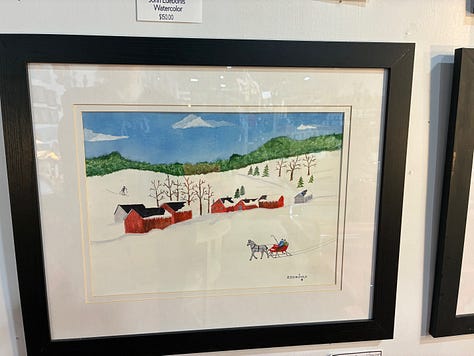
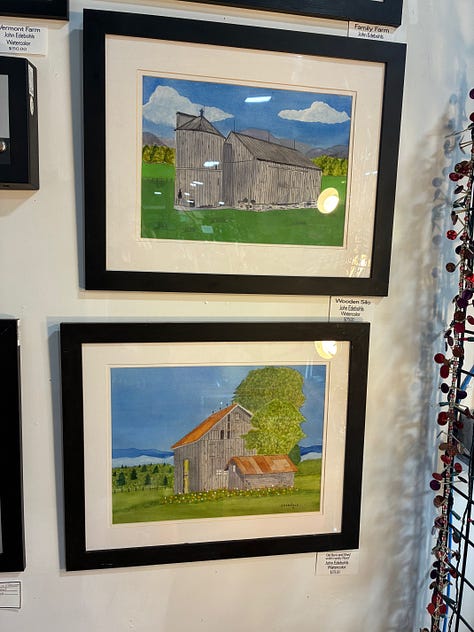
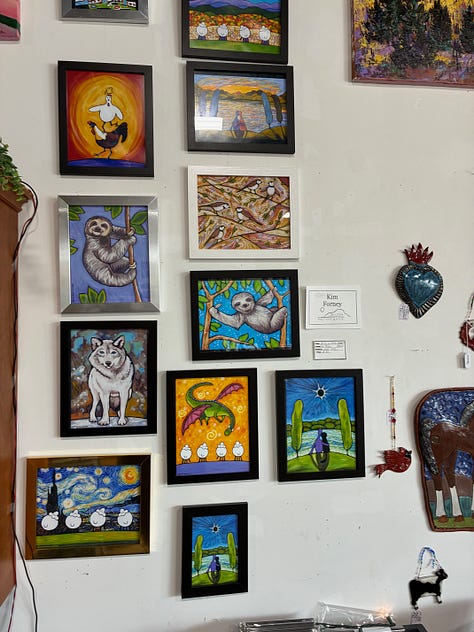
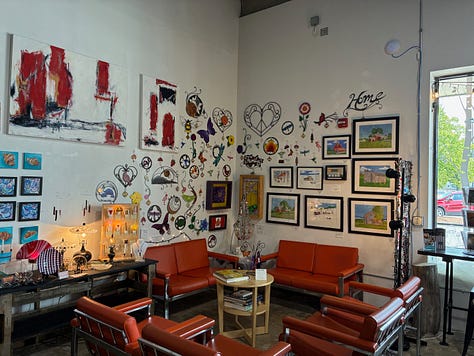
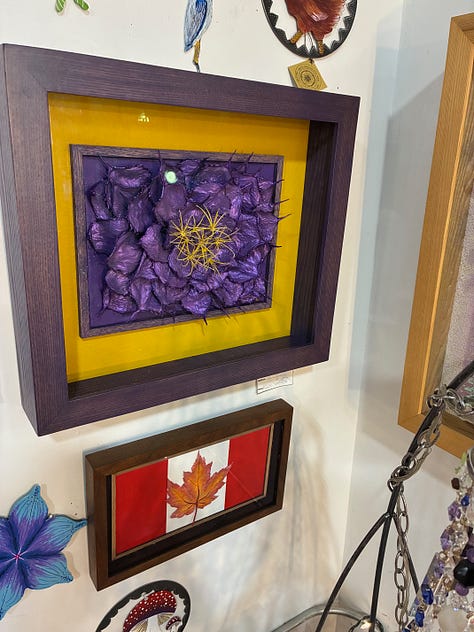
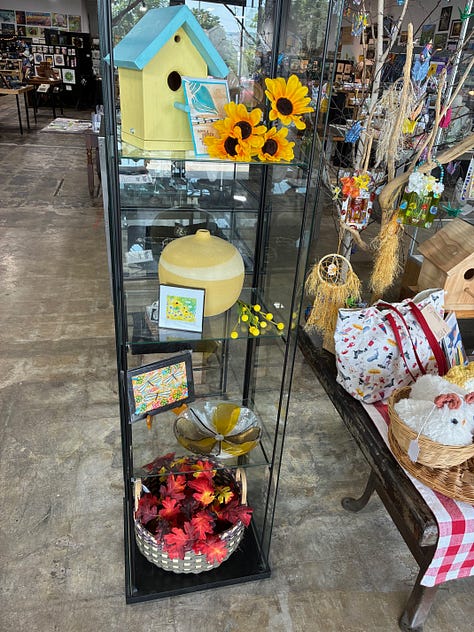
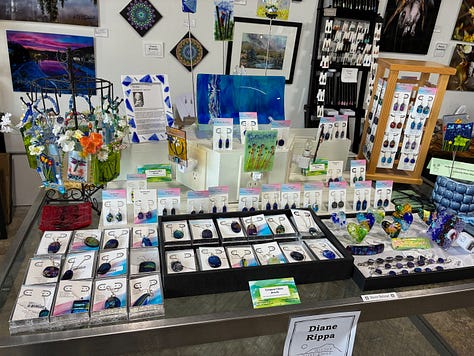
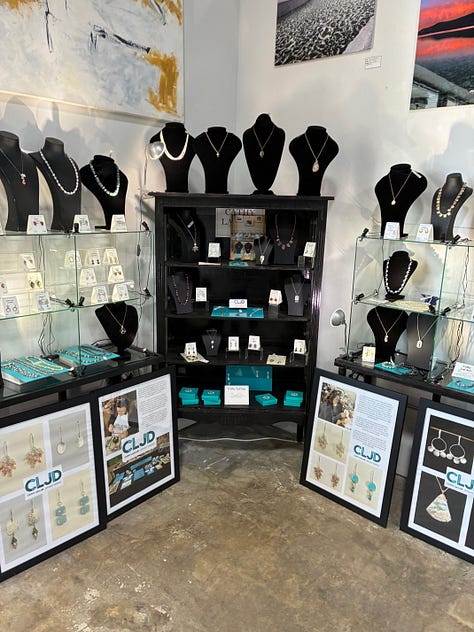

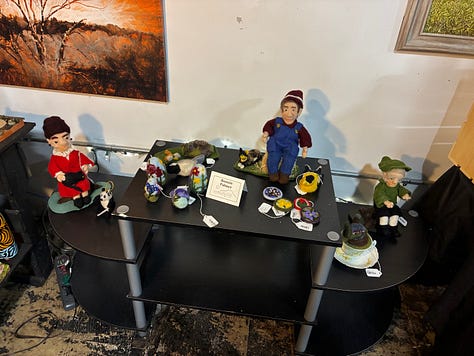
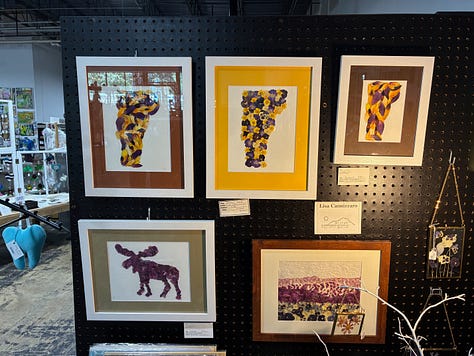
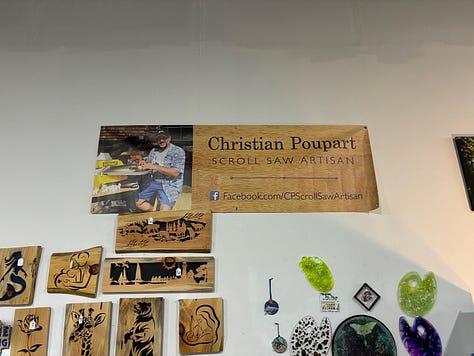
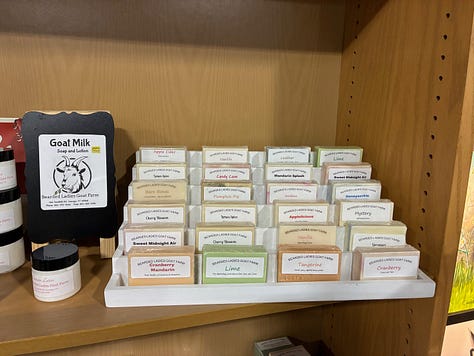
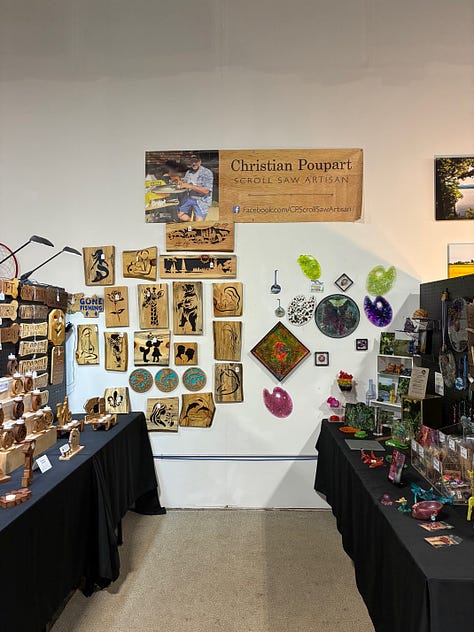
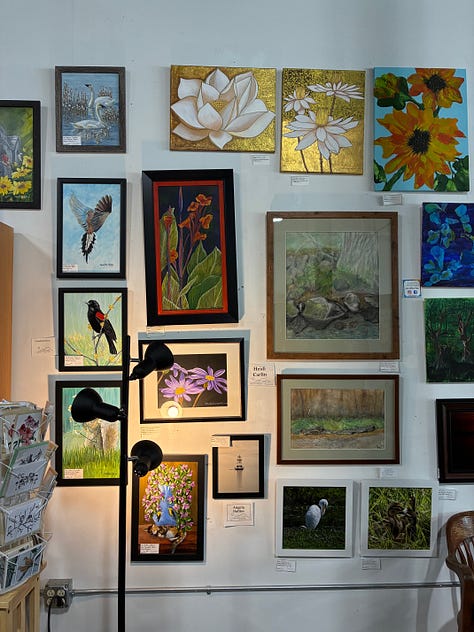
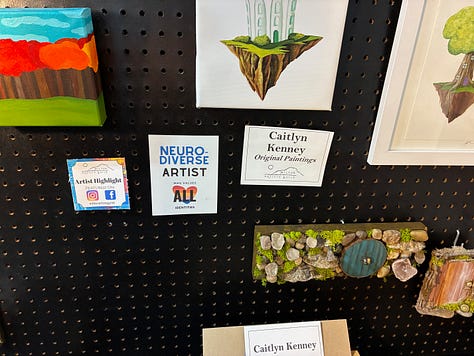
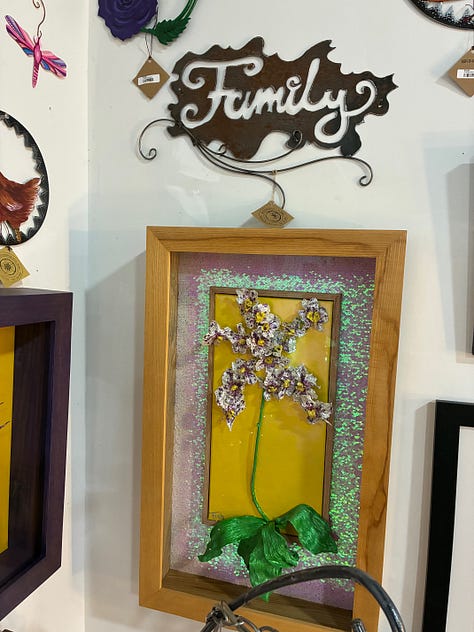
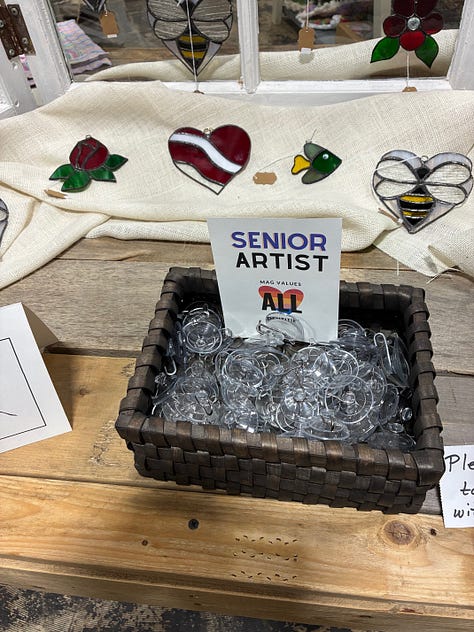
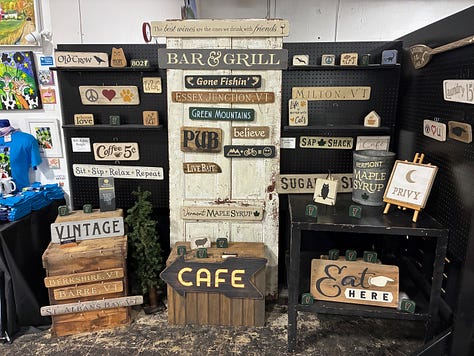
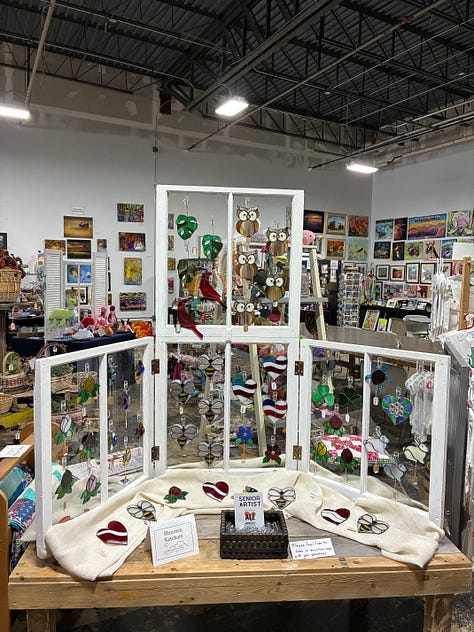
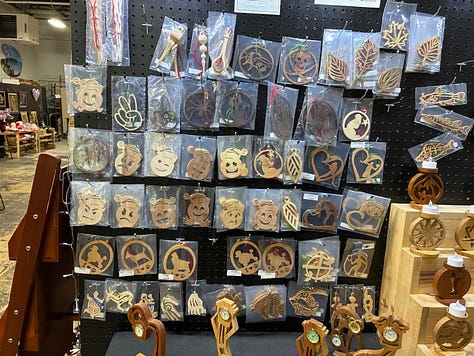
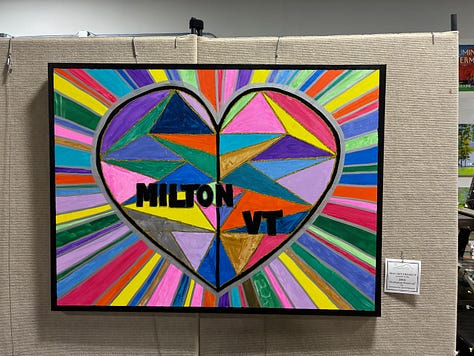

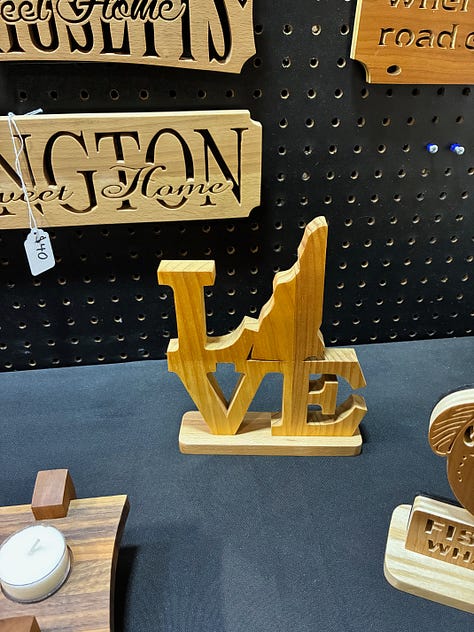

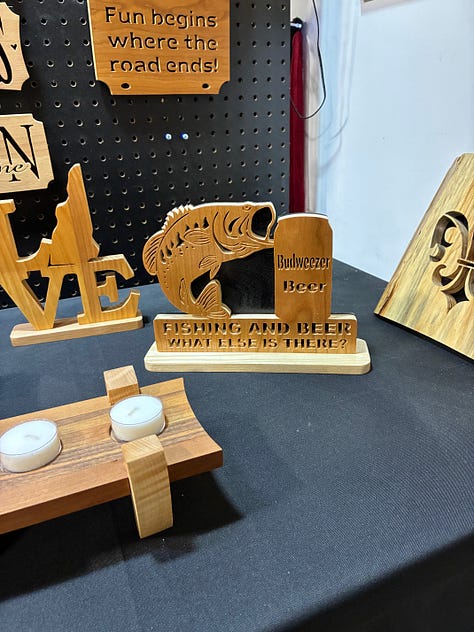
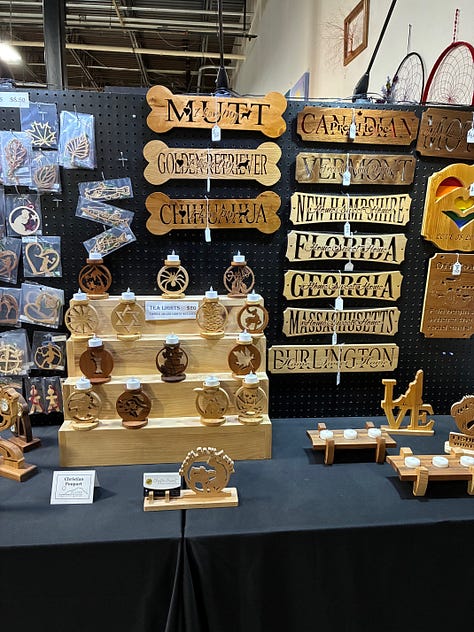
Identities Everywhere
If you’ve been scrolling through the photo galleries so far — and there are more coming — you may have noticed the little cards the Milton Artists’ Guild uses to spotlight artists’ identities. Everywhere you turn, a placard announces: BIPOC Artist. Senior Artist. Disabled Artist. LGBTQ Artist. Neurodivergent Artist.
This is the sort of thing that normally makes me twitch. Not in a righteous-anger way — more in a “here we go again” way.
The way you’d react if someone kept rearranging the silverware drawer so you could better access the forks.
I know it’s meant to help. (I do know this.)
I just…bristle. It’s a me problem; I know that.
This is the world, and my difficulty with the world is by definition my difficulty.
But here’s the thing: the Guild is so inspiring, so jam-packed with energy and talent, that instead of being irritated, I mostly laughed.
Not a mean laugh, but the kind where you roll your eyes in good humor. It did get me thinking, though. Because if any of those artists had been marked as d/Deaf, I would have wanted to know.
Not because I think art should be interpreted through the lens of the artist’s immutable characteristics — I don’t.
And not because I’d feel some compulsory solidarity and march straight to the register.
But if I had enough left in my allowance for one more piece, and it was a tie between two works I loved equally, I’d want to give my money to the Deaf artist.
I’m not entirely sure what that says about me. Maybe I’ve made deafness part of my identity in some sense deeper than I was aware of. It’s hard to tell.
Pebble Confession
Okay, fine. You caught me. I loved these.
I loved them in the kind of way where my inner child practically started doing cartwheels in the gallery, while my adult self tried to play it cool.
These framed pebble art pieces — families and friends shaped entirely out of smooth, weathered stones — are exactly the sort of thing I would make myself on a long walk, arranging little figures on a boulder or a tree stump while no one was looking, and then quietly brushing them back into the dirt so there’d be no evidence.
The idea of actually telling someone I made something like that? Absolutely not. Too embarrassing. Too risky. Too…presumptuous, somehow, to assume that my little private arrangement of pebbles could qualify as “art.”
So finding them here, not only accepted but displayed proudly — with a price tag, no less — was like catching a glimpse of some secret part of myself I’d always assumed was too silly to share.
And instead of feeling silly, I felt oddly… validated. Like maybe that impulse to make something whimsical and small out of what’s right at hand isn’t childish at all.
Maybe it’s just art that never got a frame.
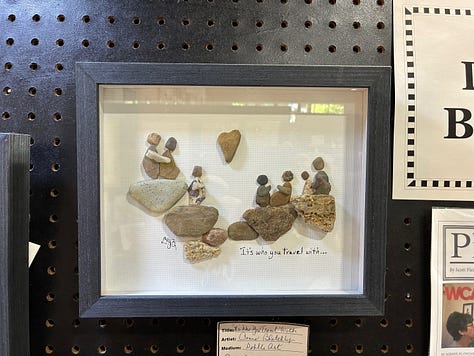
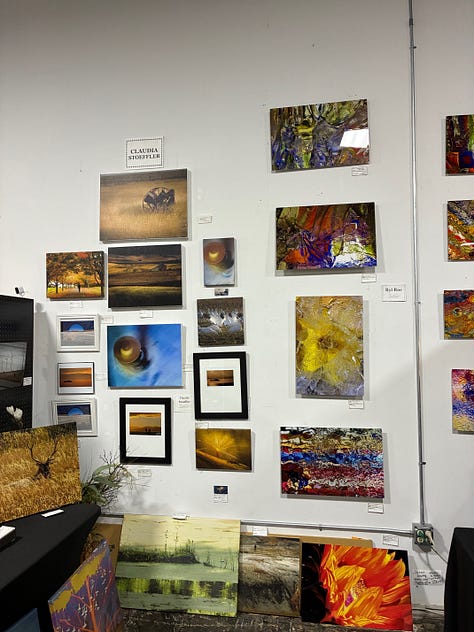
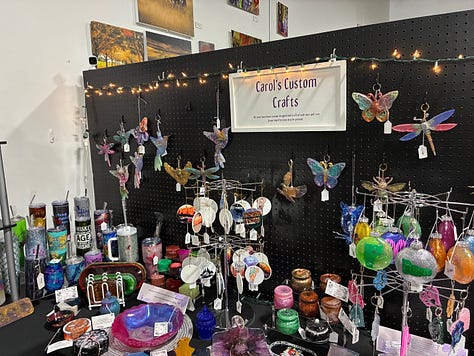
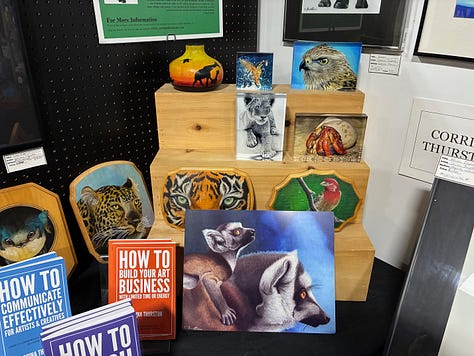
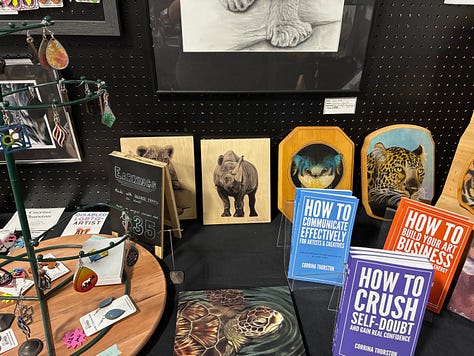
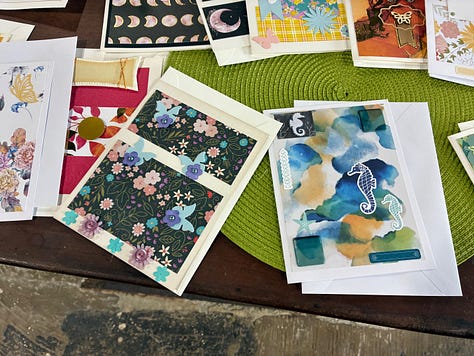
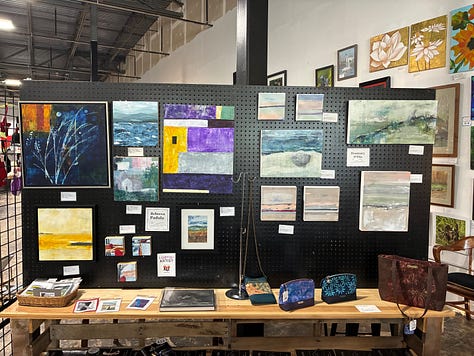
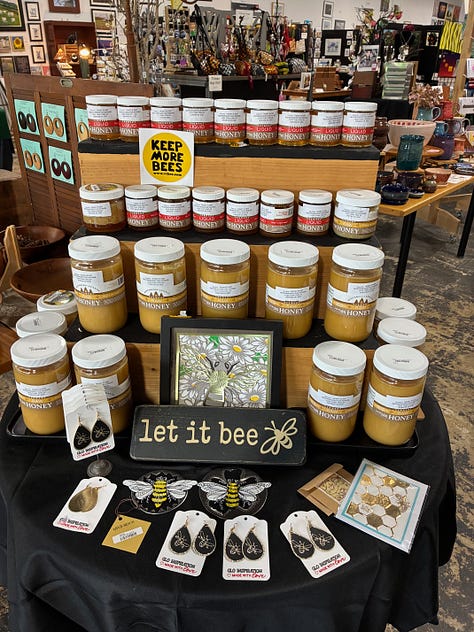
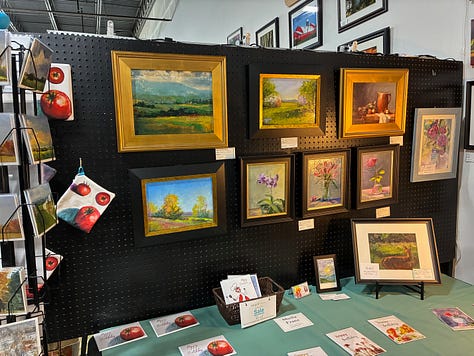
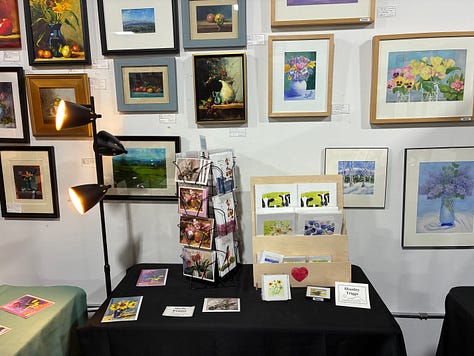
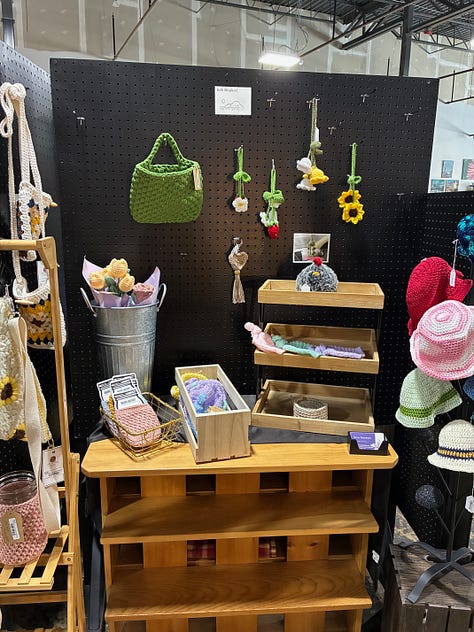
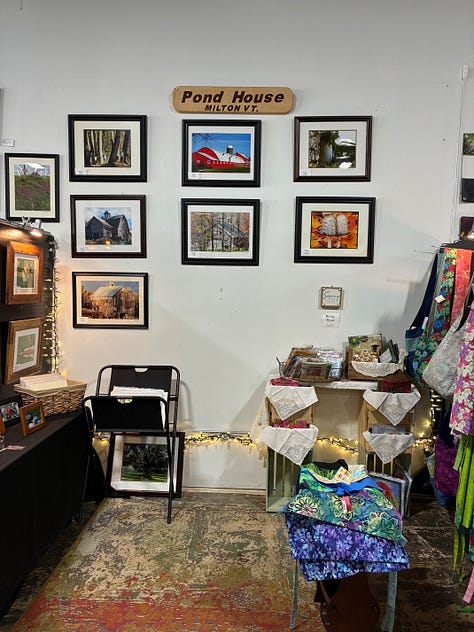

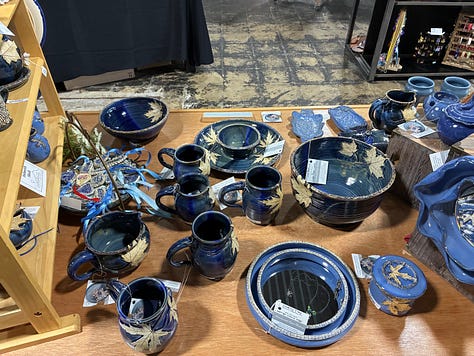
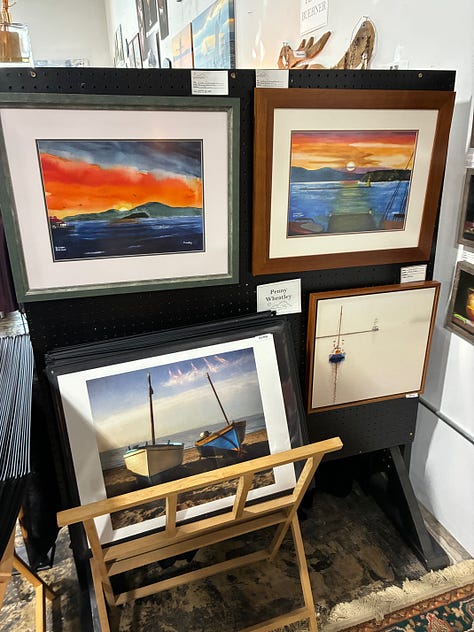
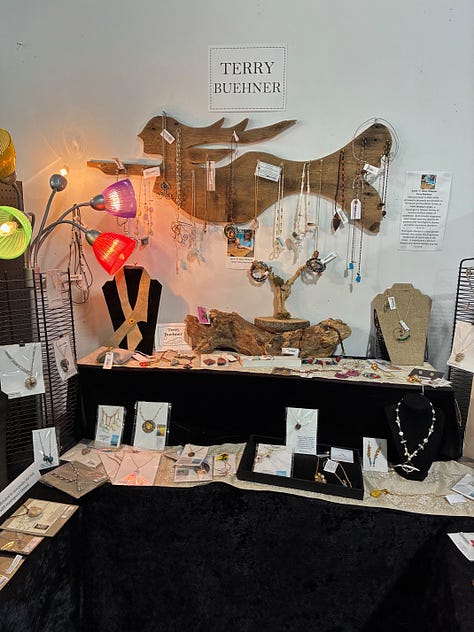
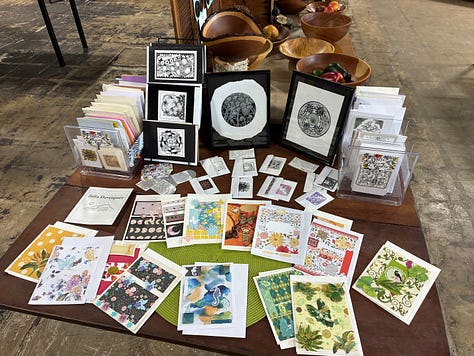
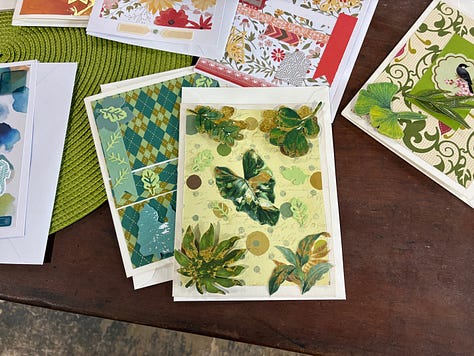
Leaving Inspired
I walked out of the Milton Artists’ Guild buzzing — the kind of happy, slightly over-caffeinated feeling you get when your brain has too many new ideas to process all at once.
By the time I got home, I’d already pulled out my white colored pencil (for drawing the outline) and acrylic paint makers (for the color) and started on a new sketchbook cover.
Halfway through, I caught myself thinking about pebble art again — how much fun it would be to make pieces like that for friends, which would require more confidence than I have.
I know I can draw fairly well, so giving drawings as gifts doesn’t feel like arrogance.
Pebble art would.
But then I thought about sketchbook and journal covers, where I’m having fun. It’s much more challenging than paper to draw on, and my skill with acrylic paint makers isn’t fabulous yet. But it’s really, really fun.
And I could completely see how living in Milton would produce that kind of artistic momentum. Whether you’re in a neighborhood where the houses are parked mobile homes or one of the fancier quarters with picture-perfect lawns, the town’s slightly off-kilter energy begs for some kind of creative outlet.
Making art here doesn’t feel optional — it feels like the natural way to metabolize the vibe.
Some towns give you a place to live.
Milton gives you material.
ONLY TWO ORIGINALS LEFT
My DIY student loan exorcism continues — and the wall is looking bare. Out of all my original drawings for sale, just two remain; the rest have already found new homes. Details and ordering info here.
NEW PRINTS AVAILABLE
Prints now available include the red Radio Flyer wagon, the bicycle-mailbox flower garden, a handful of Halloween pieces, and President Trump’s moment of defiance in the face of an assassination attempt. There’s also a pay-what-you-want option for a Texas bluebonnet. Details and ordering info here.
I’m also branching out into mixed media (acrylic paint pens) and may be offering custom journal covers soon; stay tuned!
I’m solvent only because I carry in debit, never credit, cards to art stores, ha ha.


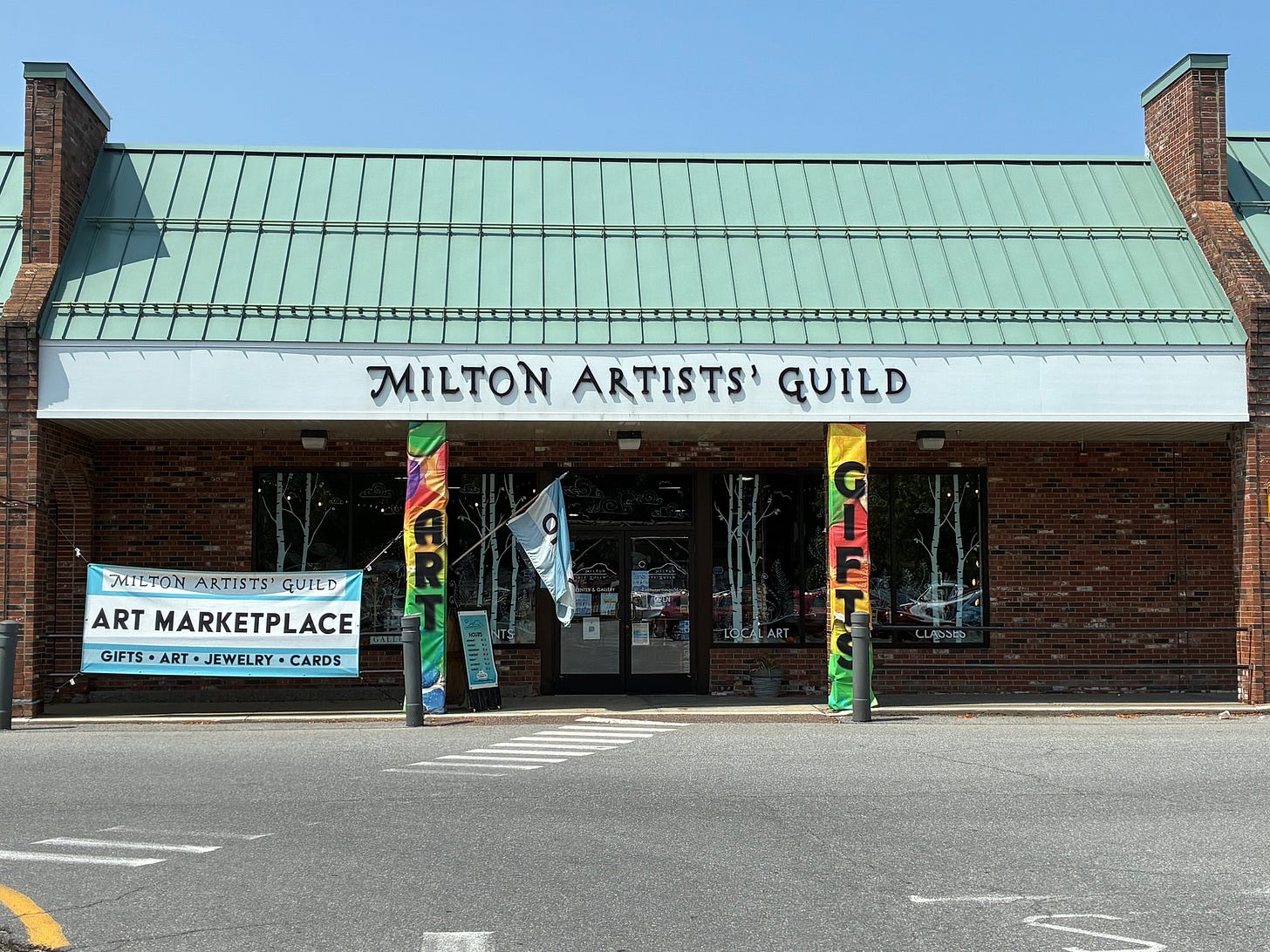
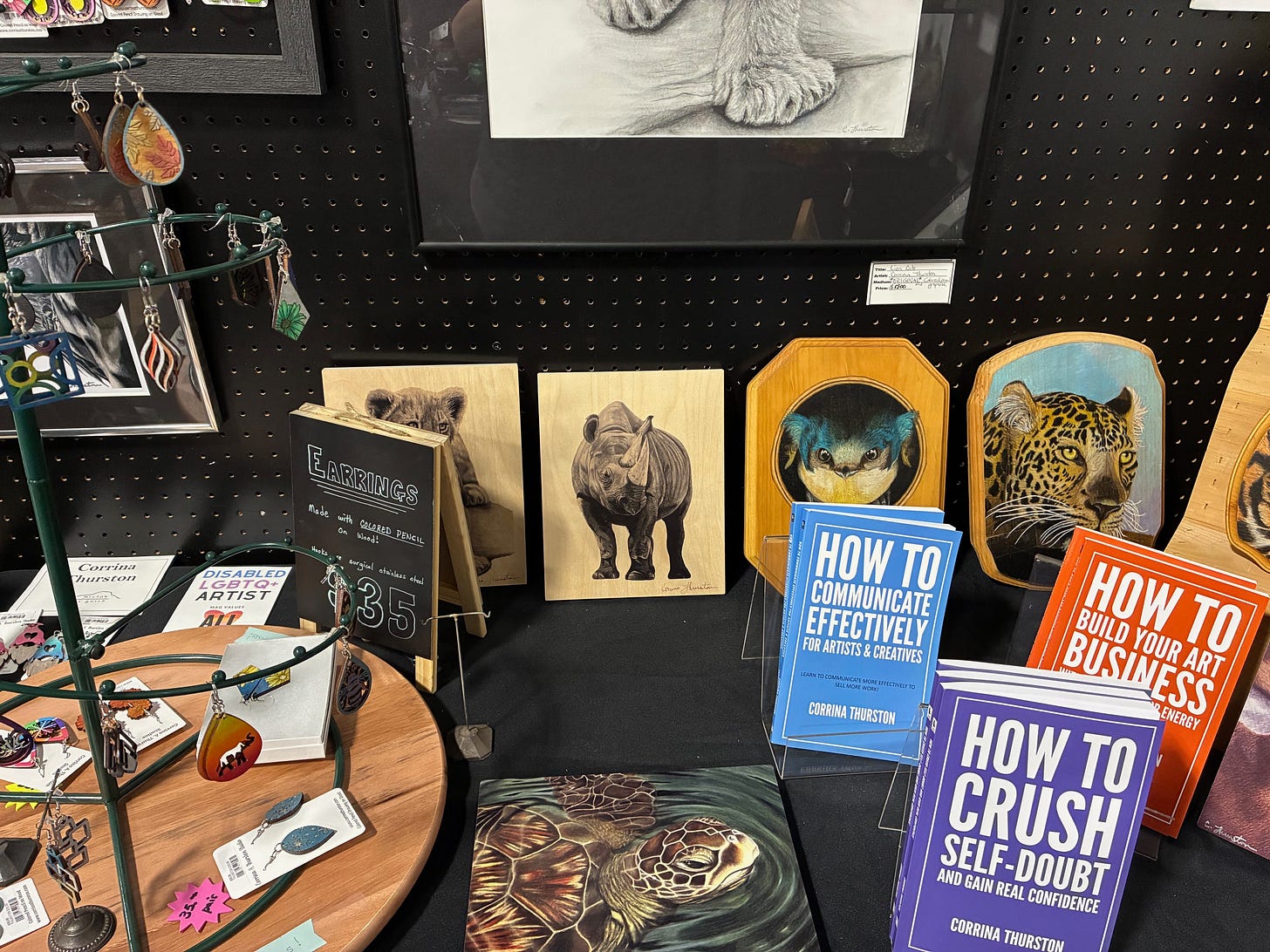
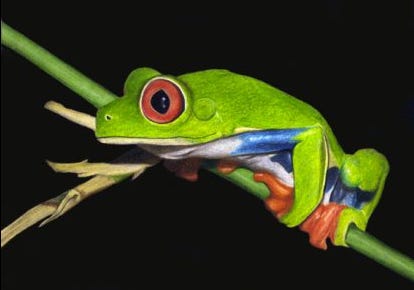
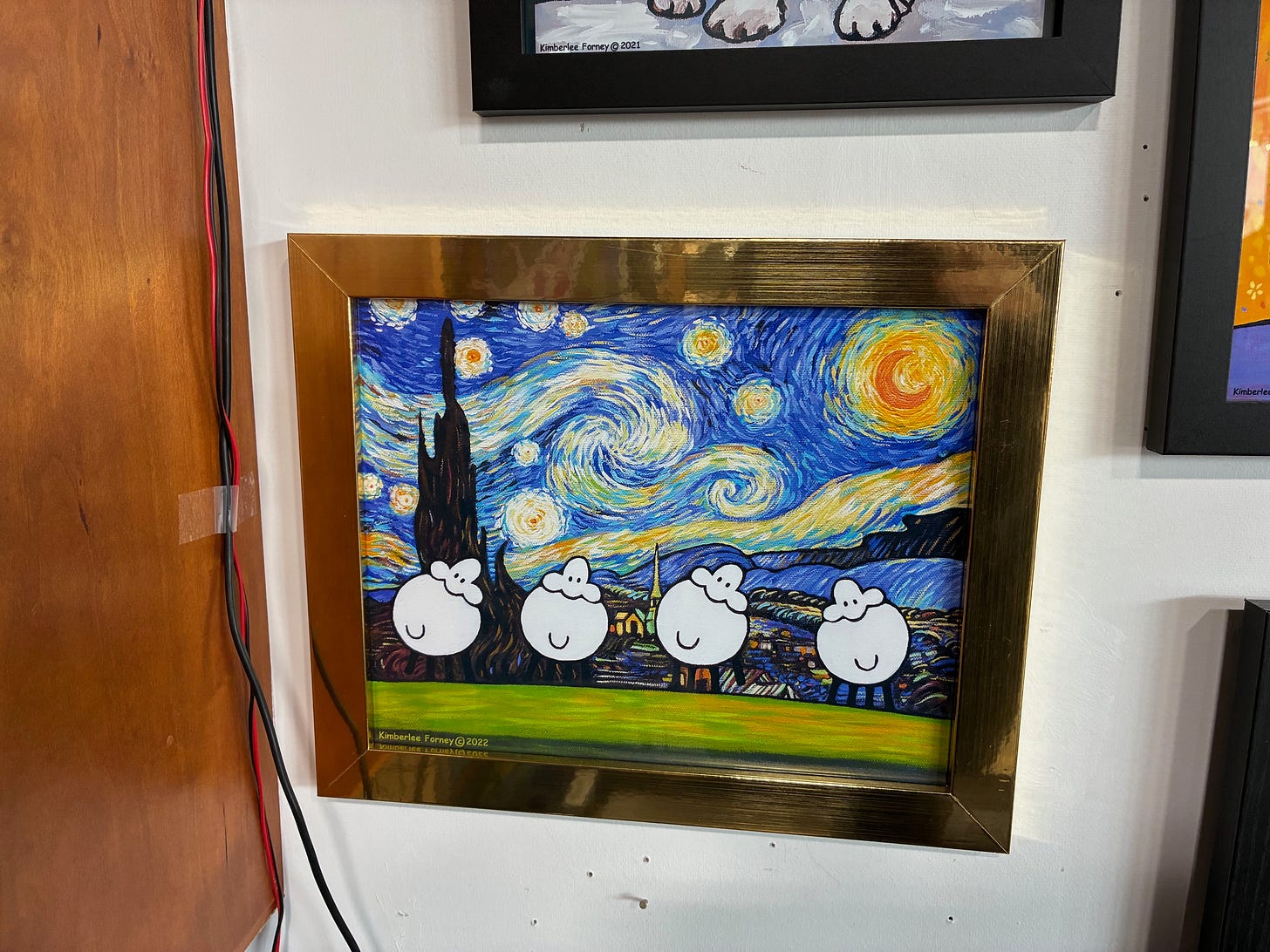
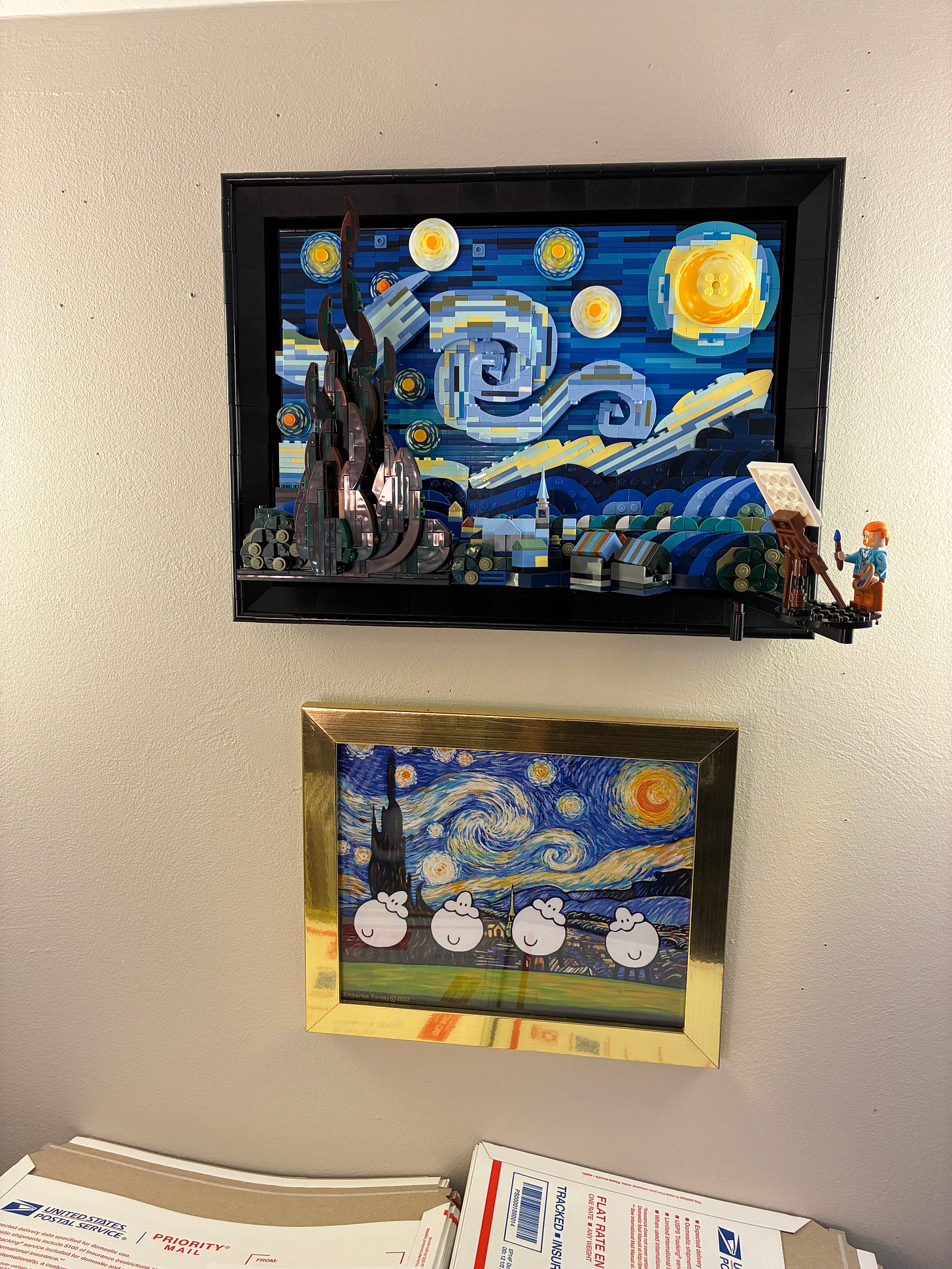
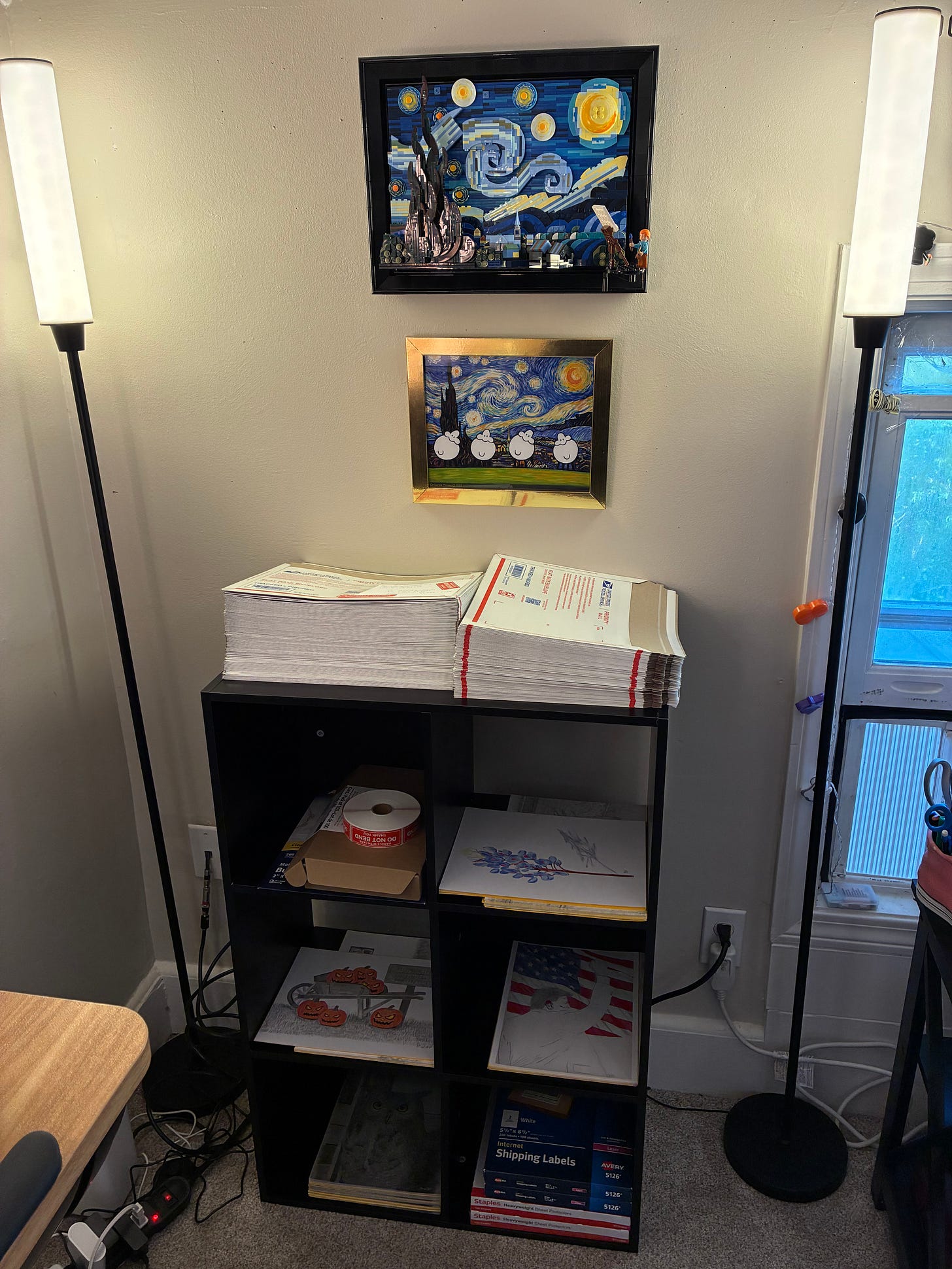
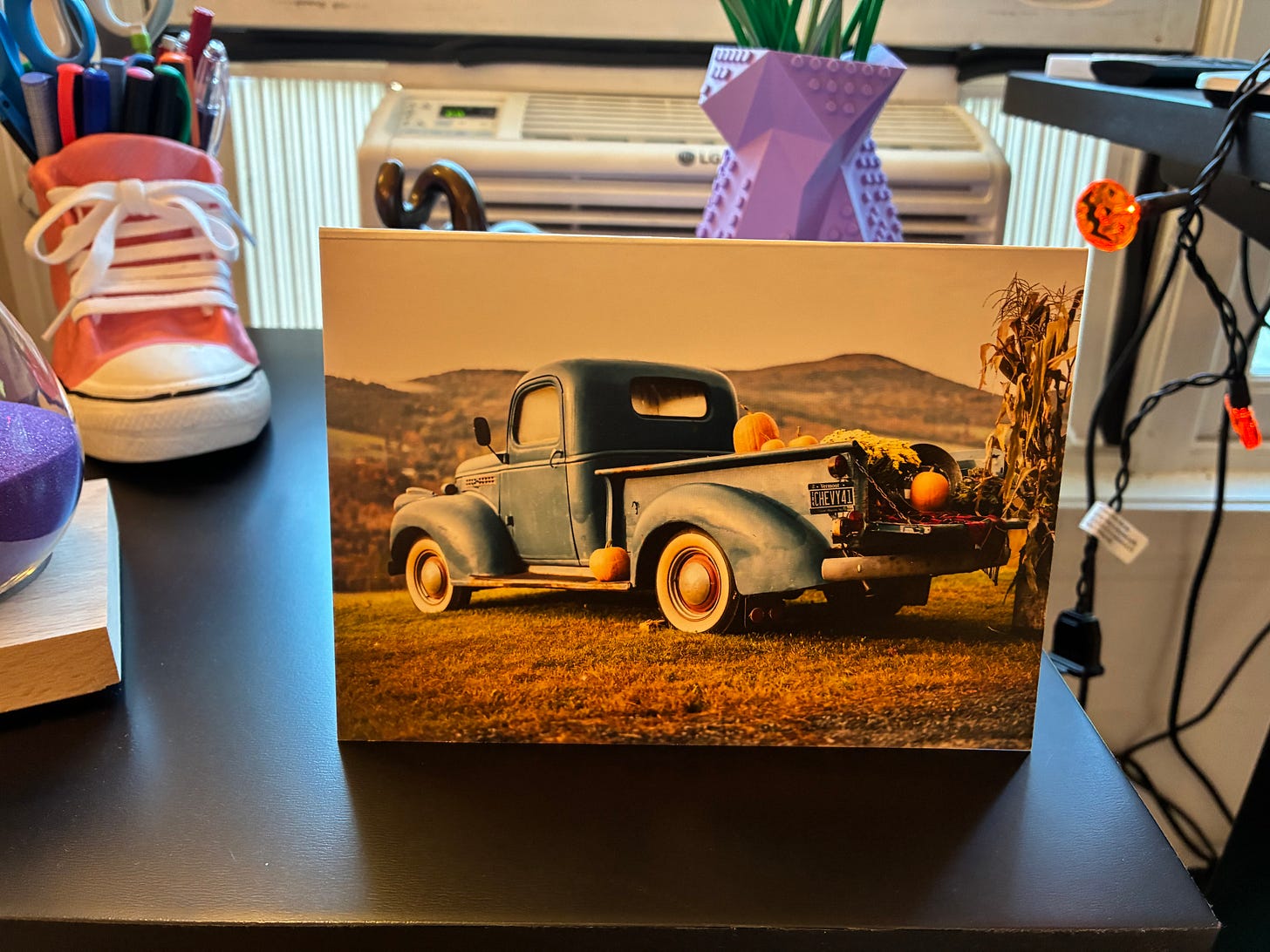
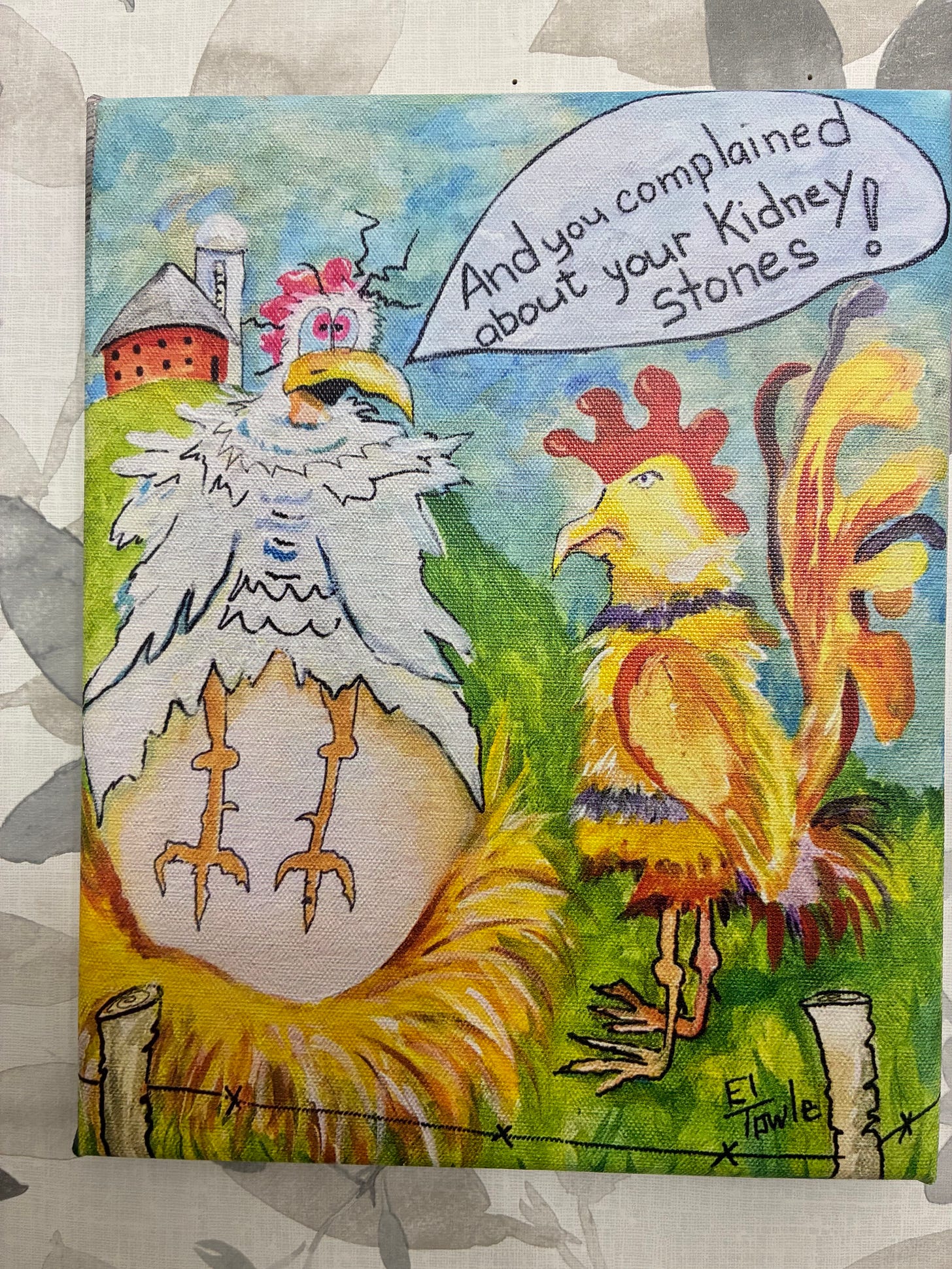
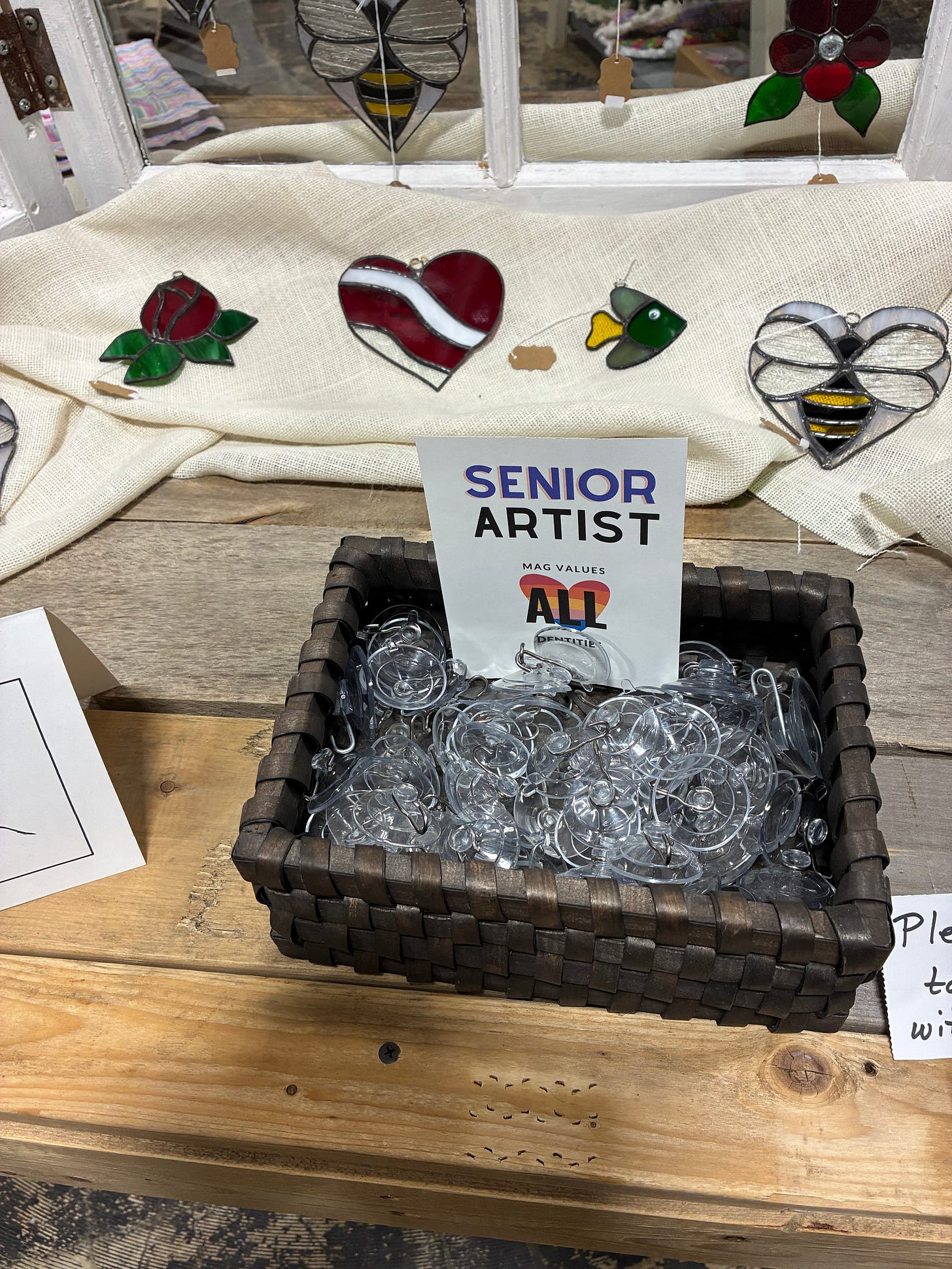
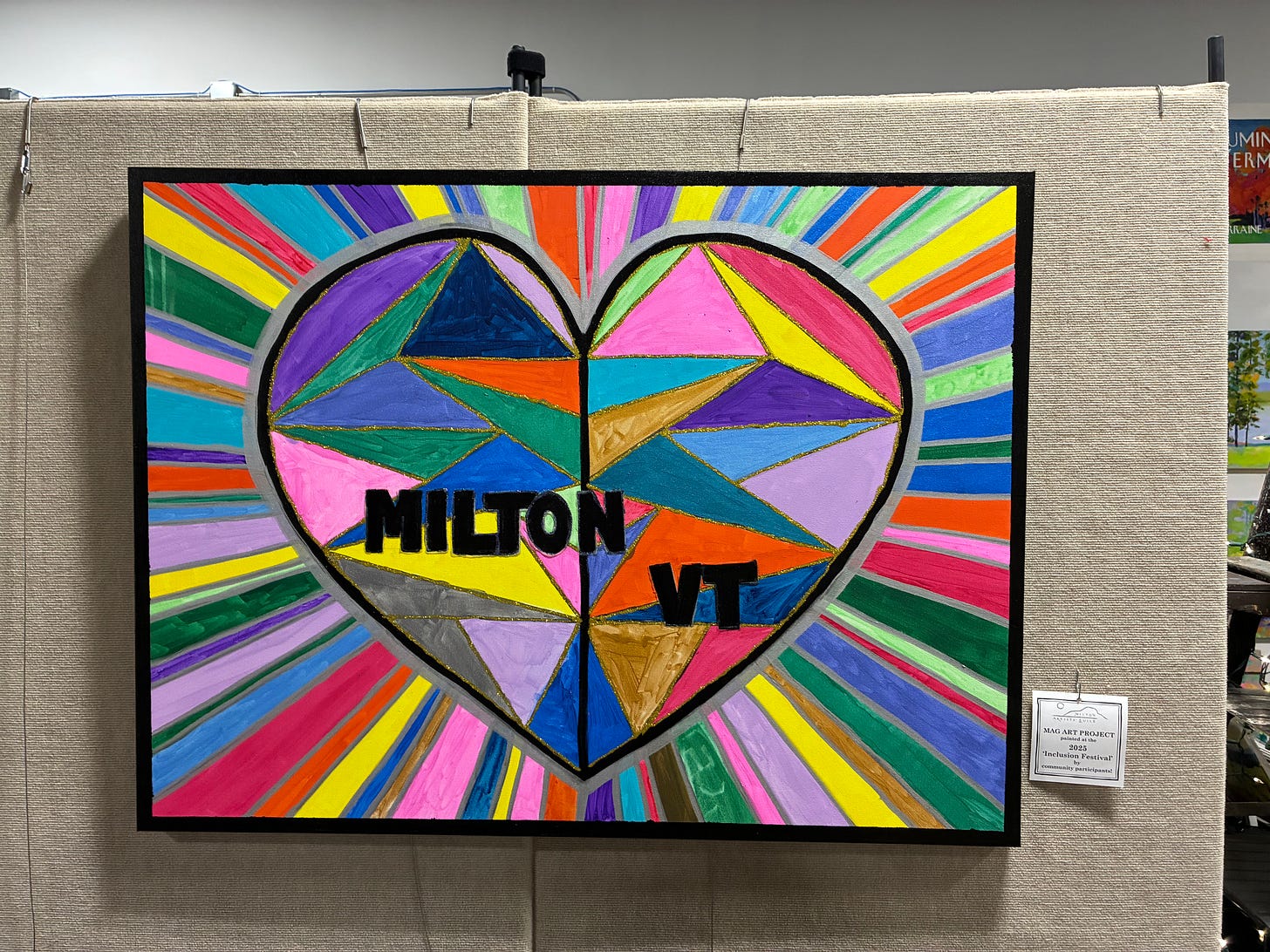

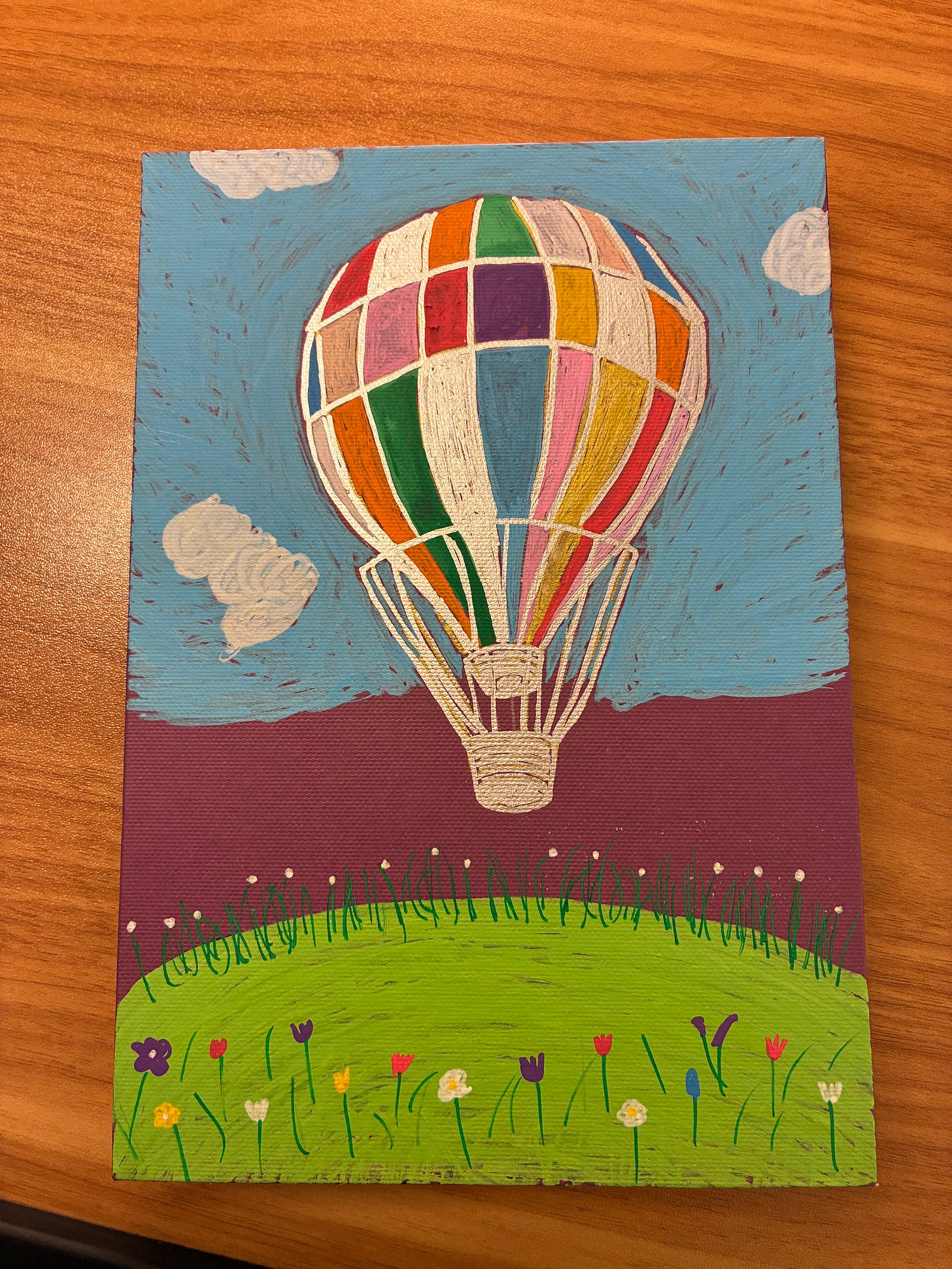
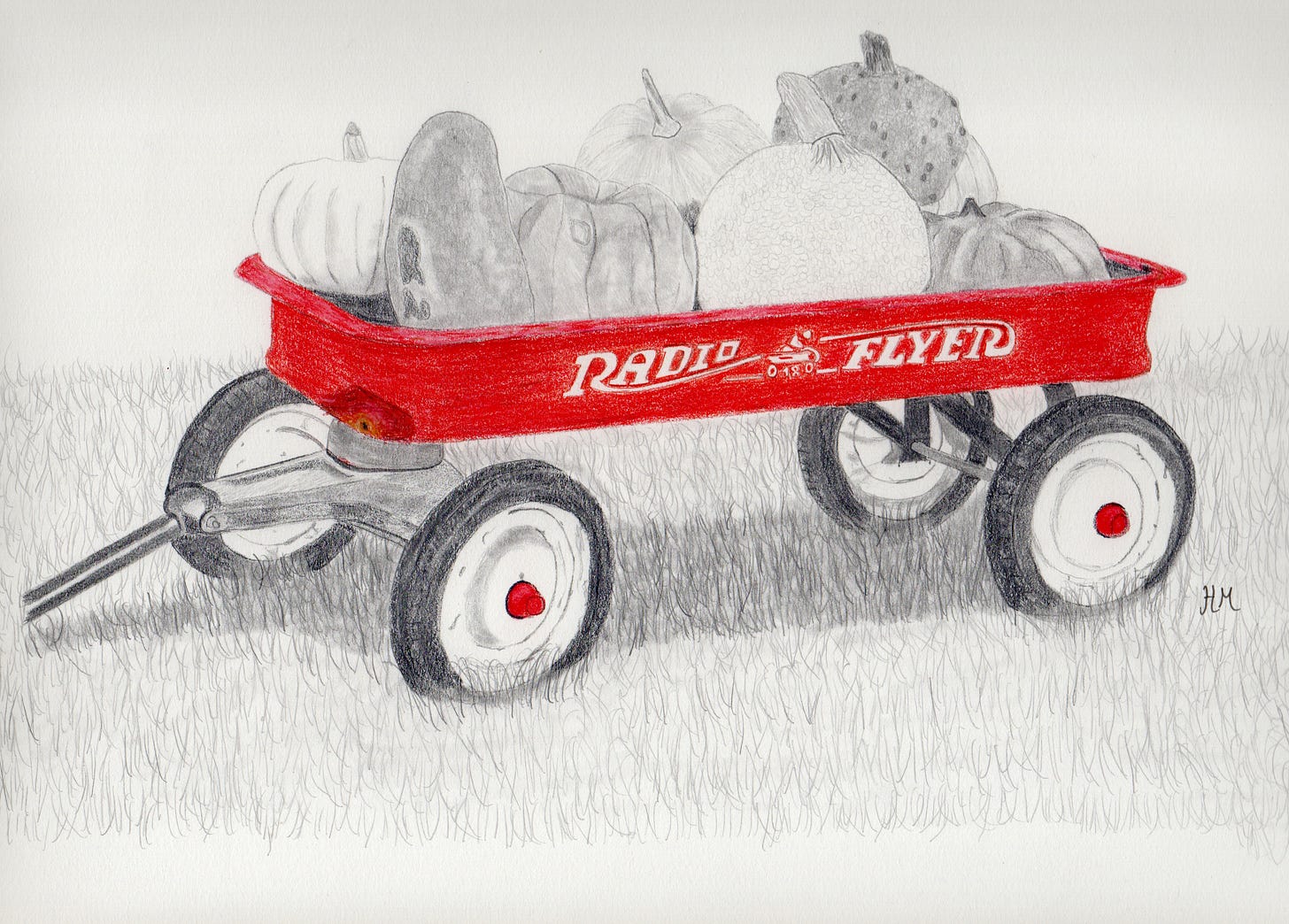
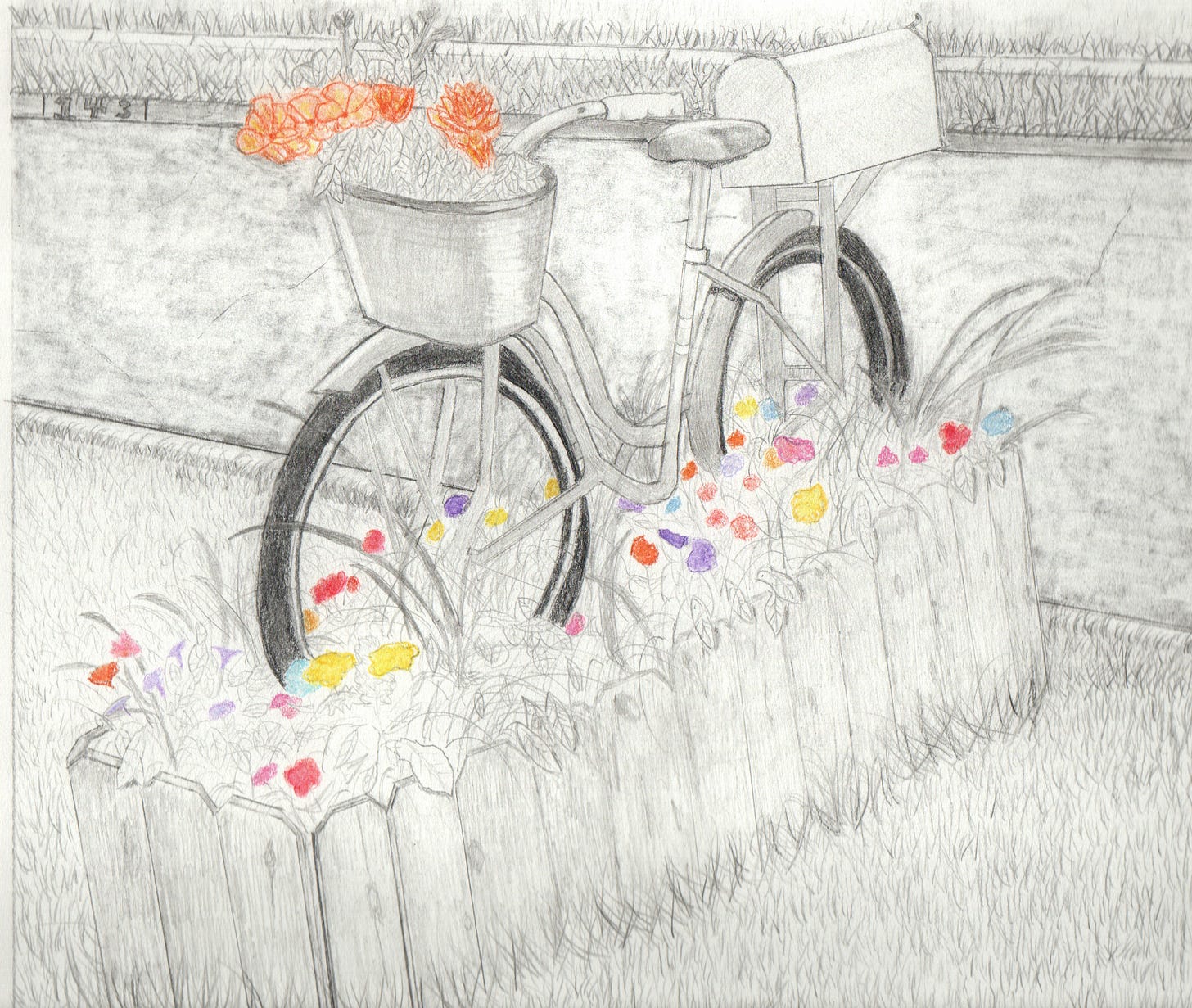
That frog was amazing, I had to look twice after reading the caption.
I love the painting with the purple barns.